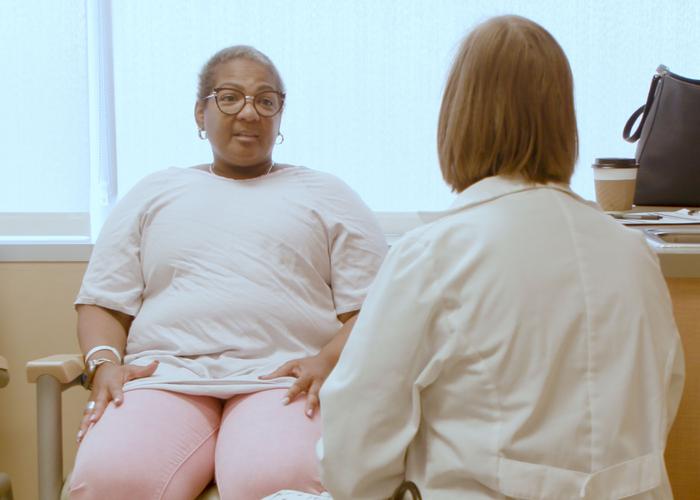Advertisment
Survey finds education is needed to identify lesser-known symptoms of breast cancer

An overwhelming majority of adults (93%) recognize a lump as a symptom of breast cancer, but less than half recognize other common symptoms associated with the disease, according to a consumer survey commissioned by The Ohio State University Comprehensive Cancer Center – Arthur G. James Cancer Hospital and Richard J. Solove Research Institute (OSUCCC – James).
Experts say this is very concerning, since most breast cancers do not present with a lump that can be detected by touch – and if they do, it often an indicates a fast-growing or advanced-stage cancer that is less treatable.
“Screening mammography is our No. 1 defense in detecting and addressing breast cancers at their earliest, most treatable stages, but it is also very important for people to be familiar with the look and feel of their own breast tissue so that sometimes subtle changes can be evaluated quickly to give us the best chance at early detection,” said Ashley Pariser, MD, a breast medical oncologist and director of breast cancer survivorship services at the OSUCCC – James.
“We want people to feel empowered about their bodies and know what is normal for them. Many breast changes are the result of aging and childbirth; however, breast cancer can present in a number of ways,” said Pariser. “It is important that people feel safe to address these concerns in a timely way with their doctor. We have made great strides in detecting breast cancers in far earlier, more treatable stages.”
These lesser-known symptoms of breast cancer include:
- retracted, inverted or downward-pointing nipple
- breast puckering (an indentation that appears when you raise your arms)
- loss of feeling in part of the breast
- pitting/thickening of the skin on the breast
- nipple discharge
In this new survey, just 31% of survey respondents recognized a retracted, inverted or downward-pointing nipple as a symptom of breast cancer, and just 39% recognized breast puckering as a symptom. Less than half of survey respondents were aware of loss of breast feeling (41%), pitting/thickening of the breast skin (45%) or nipple charge (51%) as concerns worthy of medical attention.
Confusion about breast cancer screening guidelines
Pariser noted that screening mammography remains the No. 1 tool for early detection, yet new survey results show that a third of women say they are confused about recommendations for breast cancer screenings, particularly those under age 30 (44%).
“The best way for us to find breast cancer early is for women to present as soon as they notice a change, ideally even before they see a change. So that’s why we recommend screening mammograms for those who qualify if we want to find breast cancer early,” said Pariser, who also is an assistant professor in the College of Medicine and an affiliate member of the Cancer Control Program at the OSUCCC – James.
The American College of Radiology and American College of Obstetrics and Gynecologists recommend begin screening at age 40 for people of average risk. OSUCCC – James breast cancer experts encourage each person to talk with their physician about their personal cancer risk and family history to personalize their screening plan.
Pariser notes that people with dense breast tissue should be closely monitored because they are at slightly higher risk and dense tissue can mask small tumors. Black and Ashkenazi Jewish people should also have a conversation about more intensive screening due to higher risk.
‘Won’t happen to me’ mentality
According to the American Cancer Society, breast cancer remains the most common cancer diagnosed in women behind skin cancers, with just under 300,000 new cases and 43,000 deaths expected in 2023. This new consumer survey, however, shows that few believe they will get the disease, which afflicts about one in eight women. Among respondents, 75% of women and 91% of men don’t believe they will get breast cancer.
“So, although we are making great strides in terms of detection and treatment, unfortunately we live in a world where breast cancer is still a serious concern for people,” said Pariser. “Although the disease is less common in men, 1% of breast cancers occur in men. These cancers typically present as nipple changes, so it is also important that men feel empowered to seek medical attention for concerning symptoms, especially if they have a strong family history of breast cancer.”
Study results and methodology
This study was conducted on behalf of The Ohio State University Wexner Medical Center/OSUCCC – James by SQL Server Reporting Services (SSRS) on its Opinion Panel Omnibus platform. The SSRS Opinion Panel Omnibus is a national, twice-per-month, probability-based survey. Data collection was conducted from Sept. 22-24 among a sample of 1,004 respondents. The survey was conducted via web (n=974) and telephone (n=30) and administered in English. The margin of error for total respondents is +/- 3.5 percentage points at the 95% confidence level. All SSRS Opinion Panel Omnibus data are weighted to represent the target population of U.S. adults ages 18 or older.
Breast cancer screening is available at more than a dozen locations across Columbus and the surrounding communities. To learn more about breast cancer treatment and research at the OSUCCC – James, visit cancer.osu.edu/breastcancer or call 1-800-293-5066.
IMAGE: ASHLEY PARISER, MD, SPEAKS WITH A PATIENT AT THE OHIO STATE UNIVERSITY COMPREHENSIVE CANCER CENTER—ARTHUR G. JAMES CANCER HOSPITAL AND RICHARD J. SOLOVE RESEARCH INSTITUTE ABOUT THE SUBTLE AND LESSER-KNOWN SYMPTOMS OF BREAST CANCER THAT WOMEN SHOULD BE AWARE OF.
CREDIT: THE OHIO STATE UNIVERSITY COMPREHENSIVE CANCER CENTER





